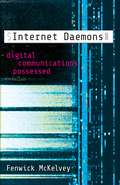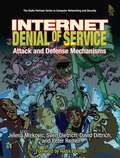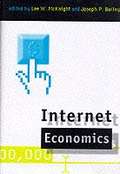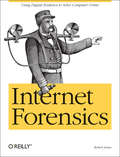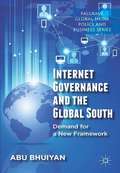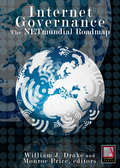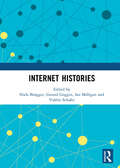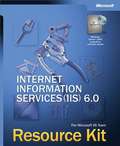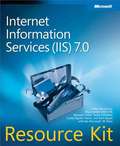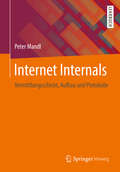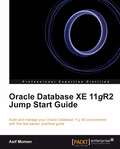- Table View
- List View
Internet Cures: The Social Lives of Digital Miracles
by Dang NguyenIn health care, we come across daily promises of miraculous cures for various ailments. However, in the digital era, the dynamics of experiencing and practicing these remedies have changed. This book explores the intersection of miracle cures and technology, showcasing their transformation into hybrid forms, such as handwritten recipes captured in photos or tutorials streamed through videos. Combining computational social media data with ethnographic insights from Vietnam and the US, the book captures the interconnected lives of these cures in the digital realm with a unique methodology. Unravelling the intricate connections between social, technological, biomedical and non-biomedical spheres, this is a significant contribution to how social scientists study online media.
Internet Daemons: Digital Communications Possessed (Electronic Mediations)
by Fenwick McKelveyA complete history and theory of internet daemons brings these little-known—but very consequential—programs into the spotlight We&’re used to talking about how tech giants like Google, Facebook, and Amazon rule the internet, but what about daemons? Ubiquitous programs that have colonized the Net&’s infrastructure—as well as the devices we use to access it—daemons are little known. Fenwick McKelvey weaves together history, theory, and policy to give a full account of where daemons come from and how they influence our lives—including their role in hot-button issues like network neutrality.Going back to Victorian times and the popular thought experiment Maxwell&’s Demon, McKelvey charts how daemons evolved from concept to reality, eventually blossoming into the pandaemonium of code-based creatures that today orchestrates our internet. Digging into real-life examples like sluggish connection speeds, Comcast&’s efforts to control peer-to-peer networking, and Pirate Bay&’s attempts to elude daemonic control (and skirt copyright), McKelvey shows how daemons have been central to the internet, greatly influencing everyday users.Internet Daemons asks important questions about how much control is being handed over to these automated, autonomous programs, and the consequences for transparency and oversight.
Internet Denial of Service: Attack and Defense Mechanisms
by Jelena Mirkovic Sven Dietrich David Dittrich Peter ReiherSuddenly your Web server becomes unavailable. When you investigate, you realize that a flood of packets is surging into your network. You have just become one of the hundreds of thousands of victims of a denial-of-service attack, a pervasive and growing threat to the Internet. What do you do? <p><p> Internet Denial of Service sheds light on a complex and fascinating form of computer attack that impacts the confidentiality, integrity, and availability of millions of computers worldwide. It tells the network administrator, corporate CTO, incident responder, and student how DDoS attacks are prepared and executed, how to think about DDoS, and how to arrange computer and network defenses. It also provides a suite of actions that can be taken before, during, and after an attack.
Internet Dos and Don'ts: Keep Your Passwords Secret
by Shannon MillerPasswords are important personal information that should not be shared--not even with a best friend. Readers will learn why password privacy is key to their safety and the potential consequences of telling others confidential information.
Internet Econometrics
by Serge Allegrezza Anne DubrocardThe proliferation of the internet has often been referred to as the fourth technological revolution. This book explores the diffusion of radical new communication technologies, and the subsequent transformation not only of products, but also of the organisation of production and business methods.
Internet Economics
by Lee W. Mcknight Joseph P. BaileyThe Internet has rapidly become an important element of the economic system. The lack of accepted metrics for economic analysis of Internet transactions is therefore increasingly problematic. This book, one of the first to bring together research on Internet engineering and economics, attempts to establish such metrics. The chapters, which developed out of a 1995 workshop held at MIT, include architectural models and analyses of Internet usage, as well as alternative pricing policies. The book is organized into six sections: 1) Introduction to Internet Economics, 2) The Economics of the Internet, 3) Interconnection and Multicast Economics, 4) Usage Sensitive Pricing, 5) Internet Commerce, and 6) Internet Economics and Policy. Contributors: Loretta Anania, Joseph P. Bailey, Nevil Brownlee, David Carver, David Clark, David W. Crawford, Ketil Danielsen, Deborah Estrin, Branko Gerovac, David Gingold, Jiong Gong, Alok Gupta, Shai Herzog, Clark Johnson, Martyne M. Hallgren, Frank P. Kelly, Charlie Lai, Alan K. McAdams, Jeffrey K. MacKie-Mason, Lee W. McKnight, Gennady Medvinsky, Liam Murphy, John Murphy, B. Clifford Neuman, Jon M. Peha, Joseph Reagle, Mitrabarun Sarkar, Scott Shenker, Marvin A. Sirbu, Richard Jay Solomon, Padmanabhan Srinagesh, Dale O. Stahl, Hal R. Varian, Qiong Wang, Martin Weiss, Andrew B. Whinston.
Internet Election Campaigns in the United States, Japan, South Korea, and Taiwan
by Diana Owen Shoko Kiyohara Kazuhiro MaeshimaThis book investigates how institutional differences, such as the roles of political parties and the regulation of electoral systems, affect the development of Internet election campaigns in the U. S. , Japan, Korea, and Taiwan. It examines whether or not the "Americanization of elections" is evident in East Asian democracies. While Japan is a parliamentary system, the U. S. and Korea are presidential systems and Taiwan is a semi-presidential system that has a president along with a parliamentary system. Furthermore, the role of the presidency in the U. S. , Korea, and Taiwan is quite different. Taking these variations in political systems into consideration, the authors discuss how the electoral systems are regulated in relation to issues such as paid advertisements and campaign periods. They argue that stronger regulation of election systems and shorter election periods in Japan characterize Japanese uniqueness compared with the U. S. , Korea, and Taiwan in terms of Internet election campaigns.
Internet Environments for Science Education
by Marcia C. LinnInternet Environments for Science Education synthesizes 25 years of research to identify effective, technology-enhanced ways to convert students into lifelong science learners--one inquiry project at a time. It offers design principles for development of innovations; features tested, customizable inquiry projects that students, teachers, and professional developers can enact and refine; and introduces new methods and assessments to investigate the impact of technology on inquiry learning. The methodology--design-based research studies--enables investigators to capture the impact of innovations in the complex, inertia-laden educational enterprise and to use these findings to improve the innovation. The approach--technology-enhanced inquiry--takes advantage of global, networked information resources, sociocognitive research, and advances in technology combined in responsive learning environments. Internet Environments for Science Education advocates leveraging inquiry and technology to reform the full spectrum of science education activities--including instruction, curriculum, policy, professional development, and assessment. The book offers: *the knowledge integration perspective on learning, featuring the interpretive, cultural, and deliberate natures of the learner; *the scaffolded knowledge integration framework on instruction summarized in meta-principles and pragmatic principles for design of inquiry instruction; *a series of learning environments, including the Computer as Learning Partner (CLP), the Knowledge Integration Environment (KIE), and the Web-based Inquiry Science Environment (WISE) that designers can use to create new inquiry projects, customize existing projects, or inspire thinking about other learning environments; *curriculum design patterns for inquiry projects describing activity sequences to promote critique, debate, design, and investigation in science; *a partnership model establishing activity structures for teachers, pedagogical researchers, discipline experts, and technologists to jointly design and refine inquiry instruction; *a professional development model involving mentoring by an expert teacher; *projects about contemporary controversy enabling students to explore the nature of science; *a customization process guiding teachers to adapt inquiry projects to their own students, geographical characteristics, curriculum framework, and personal goals; and *a Web site providing additional links, resources, and community tools at www.InternetScienceEducation.org
Internet Famous
by Danika StoneAn engaging and relatable novel for the digital age that perfectly captures the complicated interaction between what goes on in our real lives and what we say online.Internet sensation Madison Nakama has it all! Her pop-culture rewatch site has a massive following, and fans across the world wait on her every post and tweet. And now Laurent, a fellow geek (and unfairly HOT French exchange student!), has started flirting with her in the comments section of her blog. But Laurent’s not the only one watching for Madi’s replies… Internet fame has a price, and their online romance sparks the unwanted attention of a troll. When Madi’s “real life” hits a rough patch, she feels her whole world crumbling. With Laurent’s support, can Madi rally her friends across the globe to beat the troll, or will he succeed in driving her away from everything—and everyone—she loves?Internet Famous is a fresh, contemporary young adult romance for the iGeneration from Danika Stone, author of All the Feels.Praise for Internet Famous: "An enjoyable, fast-paced read to which teens will relate because of the social media–influenced format."—School Library Journal"There is much to enjoy here.... partially told through blog posts, texts, and Snapchats. There are issues of first love, cyberbulling, and parental problems." —VOYA
Internet Forensics: Using Digital Evidence to Solve Computer Crime
by Robert JonesBecause it's so large and unregulated, the Internet is a fertile breeding ground for all kinds of scams and schemes. Usually it's your credit card number they're after, and they won't stop there. Not just mere annoyances, these scams are real crimes, with real victims. Now, thanks to Internet Forensics from O'Reilly, there's something you can do about it.This practical guide to defending against Internet fraud gives you the skills you need to uncover the origins of the spammers, con artists, and identity thieves that plague the Internet. Targeted primarily at the developer community, Internet Forensics shows you how to extract the information that lies hidden in every email message, web page, and web server on the Internet. It describes the lengths the bad guys will go to cover their tracks, and offers tricks that you can use to see through their disguises. You'll also gain an understanding for how the Internet functions, and how spammers use these protocols to their devious advantage.The book is organized around the core technologies of the Internet-email, web sites, servers, and browsers. Chapters describe how these are used and abused and show you how information hidden in each of them can be revealed. Short examples illustrate all the major techniques that are discussed. The ethical and legal issues that arise in the uncovering of Internet abuse are also addressed.Not surprisingly, the audience for Internet Forensics is boundless. For developers, it's a serious foray into the world of Internet security; for weekend surfers fed up with spam, it's an entertaining and fun guide that lets them play amateur detective from the safe confines of their home or office.
Internet Freedom Software and Illicit Activity: Supporting Human Rights Without Enabling Criminals
by Martin C. Libicki Olesya Tkacheva Sasha Romanosky Zev WinkelmanThis report examines the portfolio of tools funded by the State Department s Bureau of Democracy, Human Rights, and Labor that help support Internet freedom and assesses the impact of these tools in promoting U. S. interests (such as freedom of expression, freedom of the press, and the free flow of information) without enabling criminal activity. "
Internet Governance and the Global South
by Abu BhuiyanA welcome addition to Palgrave's Global Media Policy and Business series, Internet Governance and the Global South documents the role of the global south in Internet policymaking and challenges the globalization theories that declared the death of the state in global decision-making. Abu Bhuiyan argues that the global Internet politics is primarily a conflict between the states - the United States of America and the states of the global south - because the former controls Internet policymaking. The states of the global south have been both oppositional and acquiescing to the sponsored policies of the United States on Internet issues such as digital divide, multilingualism, intellectual property rights and cyber security. They do not oppose the neoliberal underpinnings of the policies promoted by the United States, but ask for an international framework to govern the Internet so that they can work as equal partners in setting norms for the global Internet.
Internet Governance: The NETmundial Roadmap
by Monroe E. Price Patrick Ryan Larry Gross Arlene Luck Joana Varon Ferraz Matthew Shears Ronaldo Lemos Vint Cerf Emma Llansó William J. Drake Max Senges Shawn Powers Jeremy Malcolm Lea Kaspar Nnenna Nwakanma Anriette Esterhuysen Avri Doria Samantha Dickinson Wolfgang Kleinwächter Richard Whitt Markus Kummer James Losey Marilia Maciel"Following up on the promise of the NETMundial meeting, this timely and useful book explores the challenges of implementing its roadmap for the future of Internet governance." -- Milton L. Mueller, Professor, Syracuse University School of Information Studies, USAInternet Governance: The NETmundial Roadmap explores key implications of the Global Meeting on the Future of Internet Governance held on April 23-24, 2014 in São Paulo, Brazil. At the meeting, government, business, civil society, Internet technical community and academic participants from around the world agreed to a "NETmundial Multistakeholder Statement" that included a "Roadmap for the Future Evolution of Internet Governance." This volume brings together leading practitioners and scholars to explore the challenges of implementing the Roadmap's section on institutional improvements, and was prepared for release and debate at September 2014 global Internet Governance Forum in Istanbul. The 16 chapters are grouped into six sections: Overviews; Strengthening the Internet Governance Forum; Filling the Gaps; Improving ICANN; Broader Analytical Perspectives; and Moving Forward. The book was produced as a part of the Internet Policy Observatory, a program at the Center for Global Communication Studies, the Annenberg School for Communication at the University of Pennsylvania. It is edited by William J. Drake of the University of Zurich and Monroe Price of the Annenberg School for Communication.
Internet Guide to Cosmetic Surgery for Women
by M Sandra WoodLearn to use the Internet to find important information on cosmetic surgery procedures-and the right surgeon to do it!Hundreds of thousands are considering cosmetic surgery of some sort. The question is where can you go to find out what is right for you? The Internet Guide to Cosmetic Surgery for Women gives you the advantage of finding out everything you want to know about cosmetic surgery-from the comfort and privacy of your own home. This comprehensive resource guides you through the mountains of information on the Internet, providing a thorough listing of Web sites detailing every aspect of plastic and cosmetic surgery for every body part, as well as presenting strategies for finding specific information you are looking for. The Internet Guide to Cosmetic Surgery for Women gives you the tools to find information about a specific procedure, learn the surgery&’s advantages as well as risks-even how to locate the best surgeons for the procedure. The book provides screen shots to illustrate Web sites, information on where to find the latest important statistics and data, and helpful definitions for cosmetic surgery terms.The Internet Guide to Cosmetic Surgery for Women not only lists Internet addresses and basic sites on cosmetic surgery, but also reveals where to find quality information on: the costs of surgery selecting a cosmetic surgeon liposuction calf implants tummy tucks thigh lifts buttock liposculpture buttock augmentation belt lipectomy breast surgeries, including enlargement, lifts, reconstruction, and reduction cheek implants facelifts jaw augmentation laser skin resurfacing lip augmentation nose surgery cellulite treatment Botox injections hair removal hair transplantation scar revision wrinkle treatment chemical peels cosmetic dentistry and much more!The Internet Guide to Cosmetic Surgery for Women is an essential guide for anyone interested in or considering plastic and cosmetic surgery procedures.
Internet Guide to Travel Health
by Elizabeth ConnorDiscover the best Web sites for you and your family&’s well-being while traveling! The Internet Guide to Travel Health is your one-stop resource for when you need authoritative, reliable, and up-to-date information for preventing or dealing with illness and injury while traveling in the United States and abroad. For persons traveling near or far, this useful, easy-to-consult guide identifies dependable Web sites with advice, tips, and accurate facts on health issues that can affect your travel plans. You&’ll save time and effort when researching the planning, preparation, and preventive measures necessary to stay healthy while traveling. In the Internet Guide to Travel Health, you will discover a wealth of information for maintaining your health and safety throughout your trip. This book offers you Web sites to keep you informed on the latest life-threatening situations occurring throughout the world, such as disease outbreaks, epidemics, and natural disasters. With Internet addresses for what health documents to keep with you at all times, how to find doctors and clinics at your destination, and even what to do in case of a death far from home, this informative guide helps you stay organized, even in an emergency. The Internet Guide to Travel Health provides you with reliable information on: elective and compulsory immunizations, vaccinations, and examinations safety concerns with specific modes of travel-automotive, railways, air travel, cruise ships travel recommendations and accommodations for people with disabilities, seniors, children, people with HIV, and pets specific diseases, conditions, and ailments that can affect travel or be encountered while traveling-from air rage and allergies to West Nile Virus and Yellow Fever interactive tools and real-time travel advice-driving distance calculators, air flight arrival/departure delays, and traffic reports In addition to the Web site listings, the Internet Guide to Travel Health provides numerous screen shots of key Internet resources and an understandable glossary of health- and Internet-related terms. With the myriad of health and safety risks associated with traveling both nationally and internationally, this book is essential for vacationers, business travelers, explorers, and health care professionals who want to stay informed and prepared.
Internet Histories
by Niels Brügger, Gerard Goggin, Ian Milligan and Valérie SchaferIn 2017, the new journal Internet Histories was founded. As part of the process of defining a new field, the journal editors approached leading scholars in this dynamic, interdisciplinary area. This book is thus a collection of eighteen short thought-provoking pieces, inviting discussion about Internet histories. They raise and suggest current and future issues in the scholarship, as well as exploring the challenges, opportunities, and tensions that underpin the research terrain. The book explores cultural, political, social, economic, and industrial dynamics, all part of a distinctive historiographical and theoretical approach which underpins this emerging field.The international specialists reflect upon the scholarly scene, laying out the field’s research successes to date, as well as suggest the future possibilities that lie ahead in the field of Internet histories. While the emphasis is on researcher perspectives, interviews with leading luminaries of the Internet’s development are also provided. As histories of the Internet become increasingly important, Internet Histories is a useful roadmap for those contemplating how we can write such works. One cannot write many histories of the 1990s or later without thinking of digital media – and we hope that Internet Histories will be an invaluable resource for such studies. This book was originally published as the first issue of the Internet Histories journal.
Internet Information Services (IIS) 6 Resource Kit
by Microsoft Iis TeamDeploy and support IIS 6.0, which is included with Microsoft Windows Server 2003, with expertise direct from the Microsoft IIS product team. This official RESOURCE KIT packs 1200+ pages of in-depth deployment, operations, and technical information, including step-by-step instructions for common administrative tasks. Get critical details and guidance on security enhancements, the new IIS 6.0 architecture, migration strategies, performance tuning, logging, and troubleshooting--along with timesaving tools, IIS 6.0 product documentation, and a searchable eBook on CD. You get all the resources you need to help maximize the security, reliability, manageability, and performance of your Web server--while reducing system administration costs. Get in-depth guidance--straight from the Microsoft IIS team on how to: Upgrade or migrate existing IIS solutions to IIS 6.0 Migrate Apache Web sites--migration tool included on CD Deploy Microsoft ASP.NET applications on IIS 6.0 Configure and manage IIS security services Manage the IIS 6.0 metabase using built-in GUI-based and command-line utilities Run IIS 6.0 as a platform for Web applications Streamline programmatic administration with the scripts and tools on CD Apply best practices for improving server availability and scalability, including managing large-scale deployments Optimize IIS performance with effective monitoring, tuning, and troubleshooting procedures Resource Kit tools plus Windows Server 2003 evaluation software inside Use IIS 6.0 Resource Kit tools to query log files, manage security features, run stress tests, migrate servers, troubleshoot problems, and more. The CD includes the following tools: Apache to IIS 6.0 Migration Tool CustomAuth IISCertDeploy.vbs IIS Host Helper Services IIS 6.0 Migration Tool IISState Log Parser Metabase Explorer Permissions Verifier RemapUrl SelfSSL TinyGet Web Capacity Analysis Tool WFetchCD also features: 180-day evaluation version of Windows Server 2003, Standard Edition IIS 6.0 Help system Windows Registry Reference Fully searchable eBook of this complete RESOURCE KIT A Note Regarding the CD or DVD The print version of this book ships with a CD or DVD. For those customers purchasing one of the digital formats in which this book is available, we are pleased to offer the CD/DVD content as a free download via O'Reilly Media's Digital Distribution services. To download this content, please visit O'Reilly's web site, search for the title of this book to find its catalog page, and click on the link below the cover image (Examples, Companion Content, or Practice Files). Note that while we provide as much of the media content as we are able via free download, we are sometimes limited by licensing restrictions. Please direct any questions or concerns to booktech@oreilly.com.
Internet Information Services (IIS) 6.0
by Microsoft CorporationDeploy and support Internet Information Services (IIS) 6.0 with tools and technical information straight from the Microsoft IIS product team.
Internet Information Services (IIS) 7.0 Administrator's Pocket Consultant
by William R. StanekPortable and precise, this pocket-sized guide delivers immediate answers for the day-to-day administration of Web servers running Microsoft® Internet Information Services (IIS) 6.0. Zero in on core IIS support procedures and everyday tasks using quick-reference tables, step-by-step instructions, and lists. You get the focused, streamlined information you need to solve problems and get the job done--whether you're at your desk or in the field! Get fast facts to: Install Web and application server components Learn core techniques for managing IIS Configure Web sites, servers, and virtual directories Customize Web content, including error messages and redirection Manage Web applications, application pools, and Microsoft ASP.NET Configure SMTP, POP3, and advanced messaging options Implement security features--permissions, certificates, SSL Monitor and optimize IIS performance Manage IIS backups and metabase configurations
Internet Information Services (IIS) 7.0 Resource Kit
by Brett Hill Bernard Cheah Steve Schofield Kurt Meyer Microsoft Iis Team Olga M. Londer Carlos Aguiar Mares Mike VolordarskyGet the definitive reference for deploying, managing, and supporting Internet Information Services (IIS) 7.0. This official Microsoft® RESOURCE KIT provides comprehensive information and resources from Microsoft IIS Team experts who know the technology best. IIS, a service within the Windows Server® 2008 operating system, enables users to easily host and manage Web sites, create Web-based business applications, and extend file, print, media, and communication services to the Web. This RESOURCE KIT provides everything you need to know about IIS architecture, migrating servers and applications, capacity planning, performance monitoring, security features, top administration and troubleshooting scenarios, and IIS best practices. You also get an essential toolkit of resources on CD, including scripts, job aids, and a fully searchable eBook. A Note Regarding the CD or DVD The print version of this book ships with a CD or DVD. For those customers purchasing one of the digital formats in which this book is available, we are pleased to offer the CD/DVD content as a free download via O'Reilly Media's Digital Distribution services. To download this content, please visit O'Reilly's web site, search for the title of this book to find its catalog page, and click on the link below the cover image (Examples, Companion Content, or Practice Files). Note that while we provide as much of the media content as we are able via free download, we are sometimes limited by licensing restrictions. Please direct any questions or concerns to booktech@oreilly.com.
Internet Infrastructure: Networking, Web Services, and Cloud Computing
by Richard Fox Wei HaoInternet Infrastructure: Networking, Web Services, and Cloud Computing provides a comprehensive introduction to networks and the Internet from several perspectives: the underlying media, the protocols, the hardware, the servers, and their uses. The material in the text is divided into concept chapters that are followed up with case study chapters that examine how to install, configure, and secure a server that offers the given service discussed. The book covers in detail the Bind DNS name server, the Apache web server, and the Squid proxy server. It also provides background on those servers by discussing DNS, DHCP, HTTP, HTTPS, digital certificates and encryption, web caches, and the variety of protocols that support web caching. Introductory networking content, as well as advanced Internet content, is also included in chapters on networks, LANs and WANs, TCP/IP, TCP/IP tools, cloud computing, and an examination of the Amazon Cloud Service. Online resources include supplementary content that is available via the textbook’s companion website, as well useful resources for faculty and students alike, including: a complete lab manual; power point notes, for installing, configuring, securing and experimenting with many of the servers discussed in the text; power point notes; animation tutorials to illustrate some of the concepts; two appendices; and complete input/output listings for the example Amazon cloud operations covered in the book.
Internet Internals: Vermittlungsschicht, Aufbau und Protokolle
by Peter MandlLernen Sie in diesem Buch alles über Vermittlungsschicht und Aufbau des Internets und die Übertragung von InformationenSie haben sich schon immer gefragt, wie das World Wide Web aufgebaut ist? Sie suchen eine Einführung in die „Internet Internals“? Dieses Buch über die Vermittlungsschicht des Internets gibt Ihnen Antworten. Es führt Sie in die Grundlagen der Übertragung von Daten im Netz ein und vermittelt Ihnen dabei einen Überblick über den Aufbau des Internets. Die große Stärke dieses Buchs über die Vermittlungsschicht des Internets liegt darin, dass es komplexe Sachverhalte wie Protokolle und Algorithmen im Detail beschreibt, dabei jedoch stets verständlich und übersichtlich bleibt.Die Inhalte von „Internet Internals“Autor Peter Mandl gewährt dem Leser einen möglichst tiefen wie breiten Einblick in die Kommunikationsstrukturen des World Wide Webs. Der Fokus des Buch über die Vermittlungsschicht im Internet liegt auf folgenden Themengebieten:• Aufbau des Internts• Internetprotokolle IPv4 und IPv6• Routing und Forwarding• Internet-Kommunikation• Konfigurations- und SteuerprotokolleMit all seiner Expertise ist Mandl dazu in der Lage, komplexe Sachverhalte des Internets einfach und verständlich darzulegen. Auch die zahlreiche Abbildungen helfen dabei, seine Ausführungen leicht nachzuvollziehen. Damit das Gelernte im Gedächtnis bleibt, finden Sie am Ende des Buchs Übungsaufgaben zu jedem Kapitel. Da die Lösungen direkt mitgeliefert werden, können Sie Nicht-Verstandenes noch einmal nachprüfen.
Internet Literature in China (Global Chinese Culture)
by Michel HockxSince the 1990s, Chinese literary enthusiasts have explored new spaces for creative expression online, giving rise to a modern genre that has transformed Chinese culture and society. Ranging from the self-consciously avant-garde to the pornographic, web-based writing has introduced innovative forms, themes, and practices into Chinese literature and its aesthetic traditions. Conducting the first comprehensive survey in English of this phenomenon, Michel Hockx describes in detail the types of Chinese literature taking shape right now online and their novel aesthetic, political, and ideological challenges. Offering a unique portal into postsocialist Chinese culture, he presents a complex portrait of internet culture and control in China that avoids one-dimensional representations of oppression. The Chinese government still strictly regulates the publishing world, yet it is growing increasingly tolerant of internet literature and its publishing practices while still drawing a clear yet ever-shifting ideological bottom line. Hockx interviews online authors, publishers, and censors, capturing the convergence of mass media, creativity, censorship, and free speech that is upending traditional hierarchies and conventions within China—and across Asia.
Internet Marketing
by Matt BaileyProven, task-based approach to developing winning internet marketing campaignsIf you've been seeking a practical, day-by-day, do-it-yourself plan for success in your Internet marketing, this is the book for you. The latest in the very popular Hour a Day series, this book gives you step-by-step instruction and clear action plans for all crucial aspects of successful internet marketing: SEO, website optimization, integration of social media and blogs, and pay-per-click strategies. Above all, it shows you how to use analytics effectively, so you can track and understand your results, then course-correct as you need.Provides step-by-step instruction to help you design, implement, and measure an internet marketing strategyUses the empowering and winning approach that has made the books in the Hour a Day series top sellersBreaks down intimidating topics into approachable, hour-a-day tasksCovers key topics in step-by-step detail, including SEO, website optimization and usability, analytics, blog integration, social media, and pay-per-click strategiesOffers expert guidance from an experienced and well-known internet marketer, Matt BaileyDrive targeted traffic to your site, keep them there, and convert them into happy customers with this refreshingly practical, roll-up-your-sleeves guide!
Internet Marketing with WordPress
by David MercerThe book's accompanying Interactive learning environment on siteprebuilder.com gives you an online place to enhance and extend your practical experience through exercises, consolidate your learning and theoretical knowledge with marked quizzes, interaction with your WordPress marketing community, and fun and exciting extras such as challenges and competitions. This book is for people already using WordPress, who want more visitors, better visitors, and to convert more of them into paying customers. No prior marketing experience is required, although a basic understanding of either hosted or self-hosted WordPress blogs is assumed.

